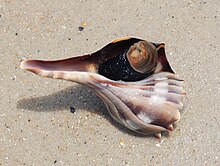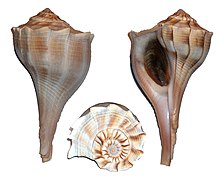Lightning snail
| Lightning snail | ||||||||||||
|---|---|---|---|---|---|---|---|---|---|---|---|---|

Lightning snail (very bright) in Smyrna Dunes Park |
||||||||||||
| Systematics | ||||||||||||
|
||||||||||||
| Scientific name | ||||||||||||
| Busycon perverse | ||||||||||||
| ( Linnaeus , 1758) |
The lightning snail ( Sinistrofulgur perversum , Syn .: Busycon perversum ) is a very large species of snail with a left-handed shell from the Buccinidae family that lives in the western Atlantic on the coast of North America . According to current research results, all recent left-wound snails of the genus Busycon are grouped under the species name Busycon perversum von Linné , including those previously listed under the names Busycon contrarium and Busycon sinistrum .
features
The left-wound, very strong and thick, pear-shaped snail shell of the lightning snail, which can be about 6 to 41 cm long in fully grown snails, has a low thread, a long and wide, inflated body circumference over the entire length and a long, egg-shaped housing mouth that runs out into a long, open siphon channel. The up to 8 angular whorls are occupied at the edge towards the apex with a row of nodes, which on the last whorls can become scale-shaped spines and from which axial ridges sometimes run in the direction of the canal. The thick, horny, dark brown operculum is egg-shaped. The surface of the housing is beige in color and has axially extending purple-brown stripes. Young animals still have brightly colored housings, but the colors fade with increasing age, so that the housing takes on a dull grayish white color.
The worm itself is dark brown to black, but sometimes very bright. The Sipho projects in active snail hardly out of the channel. The foot is smaller than that of the thin-skinned Busycotypus spiratum , which belongs to the same subfamily , and the lightning snail crawls more slowly.
The lightning snail is very similar to its sister species Busycon carica , from which it differs in particular in the direction in which the shell turns.
Occurrence
The lightning snail is found in the western Atlantic on the coast of North America from New Jersey southwards, on the Florida coast and in the Gulf of Mexico .
It lives in the intertidal zone , around estuaries and on oyster beds .
Life cycle
Like other new snails, the lightning snail is sexually separate. In the period from late autumn to early winter, the males mate the females with their penis . In early spring the females lay up to 86 cm long cords with up to 3 cm large disc-shaped egg capsules. The clutches are anchored in the sand and separate when the juvenile snails hatch. One egg capsule contains about 20 to 100 eggs, about every fifth to tenth of which develop into a snail, while the others serve as food eggs. The development of the Veliger stage takes place in the egg capsule, so that, depending on the temperature, 3 to 13 months after egg laying - on the Gulf coast of Florida from May - ready-made snails hatch, which have about 4 mm long shells. The snail grows rather slowly and only from a temperature of 20 ° C.
nutrition
Lightning snails are carnivores that feed primarily on mussels . The snail presses open the shell halves of the mussel with its foot. If this does not succeed, it breaks a piece of the shell with the edge of the housing. Then it leads the proboscis to the meat of the prey, which is minced with the help of the radula . A 30 cm long lightning snail was observed in Alligator Harbor (Florida), which opened the shell of the prey by rhythmically exerting pressure with the edge of its shell on the vertebra of a 6 cm long American oyster followed by a strong push and then opened most of the prey within 2 minutes of the meat ate while the rest was washed away.
Unlike thin-shelled predatory snails such as Busycotypus spiratus , the lightning snail mainly eats thick- shelled mussels. The prey animals include strong, thick-shelled mussels such as Lucina floridana , Chione cancellata , Cardita floridana , Macrocallista nimbosa , Noetia ponderosa and Modiolus americanus . The lightning snail can significantly influence the population dynamics of its prey. A large lightning snail can eat 3 full-grown oysters in one day or 60 oysters in 3 weeks.
Human use and exposure

Lightning snails have been collected for their meat and shell for thousands of years. Tools such as spatulas and chisels were made from the houses. In addition, the bowls were made into jewelry. The left-hand winding shell of the lightning snail had a magical meaning for some ethnic groups.
As an important predator for oysters , the lightning snail is undesirable for commercial mussel producers . To this day, the snail is a popular collector's item because of its meat and large housing. By overfishing the average case size has declined in recent decades.
Others
After the death of the lightning snail, the shell is often populated by slippers ( crepidula ) and hermit crabs .
Systematics
The type of snail was described by Carl von Linné in 1758 in the Systema Naturae as Murex perversus , a snail with an open and backward curved shell with a left-hand, slightly crowned thread. The generic name Busycon is first mentioned in 1798 by Peter Friedrich Röding in the catalog of the Conchyliensammlung of Joachim Friedrich Bolten with 6 species, including 2. B. Perversum, the left-handed fig. In 1840 Timothy Abbott Conrad described a fossil snail with "underdeveloped spines" from the Pliocene from North Carolina as a Busycon contrarium . In 1939, Burnett Smith regarded the lightning slugs living on the east coast of the USA as a mere "breed of Busycon contrarium Conrad". In rejecting this assumption, SC Hollister described three different recent species on the North American coast in 1958: Busycon sinistrum (distributed from Cape Hatteras to Yucatán ), Busycon aspinosum (around Sarasota , Florida) and Busycon pulleyi (from Louisiana to northern Mexico ). Another species description followed for Busycon laeostomum Bretton W. Kent, 1983 (distribution from southern New Jersey to northern Virginia ). As early as 1959, however, TE Pulley was of the opinion that all recent left-handed Busycon belonged to one species. This is confirmed by molecular genetic studies from 1997 and 1998. Thereafter, the name going back to Linné takes precedence, hence the species Busycon perversum ( Linnaeus , 1758) with the subspecies Busycon perversum perversum ( Linnaeus , 1758) on the coast of Yucatán, Busycon perversum sinistrum (Hollister, 1958) im Northern part of the Gulf of Mexico and Busycon perversum laeostomum (Kent, 1983) on the Atlantic coast.
In the past, the genus Busycon and the related genus Busycotypus were counted among the Melongenidae . On the basis of anatomical studies of the digestive system and a cladistic analysis on a molecular genetic basis by Kosyan and Kantor (2004), these two genera are now included in the family of horned snails (Buccinidae).
Individual evidence
- ↑ World Register of Marine Species , Sinistrofulgur perversum (Linnaeus, 1758) , Busycon perversum (Linnaeus, 1758)
- ↑ a b J. Wise, MG Harasewych, RT Dillon Jr. (2004): Population divergence in the sinistral whelks of North America, with special reference to the east Florida ecotone ( Memento of the original from August 24, 2012 in the Internet Archive ) Info : The archive link was inserted automatically and has not yet been checked. Please check the original and archive link according to the instructions and then remove this notice. (PDF; 657 kB) . Marine Biology 145, pp. 1167-1179.
- ↑ a b c d Bretton W. Kent (1983): Natural history observations on the busyconine whelks Busycon contrarium (Conrad) and Busycotypus spiratum (Lamarck) . Journal of Molluscan Studies 49 (1), pp. 37-42.
- ^ A b Winston R. Menzel, Fred E. Nichy (1958): Studies of the Distribution and Feeding Habits of Some Oyster Predators in Alligator Harbor, Florida . Bulletin of Marine Science 8 (2), pp. 125-145.
- ^ Robert T. Paine (1962): Ecological Diversification in Sympatric Gastropods of the Genus Busycon . Evolution 16 (4), pp. 515-523.
- ^ Frederick Starr (1897): A Shell Gorget from Mexico . Proceeding Davenport Academy of Natural Sciences VI, pp. 173-178.
- ^ WM Marquardt: Shell Artifacts from the Caloosahatchee Area . In: WH Marquardt (Ed.): Culture and Environment in the Domain of the Calusa , pp. 191-228. Institute of Archeology and Paleoenvironmental Studies, Monograph 1. University of Florida, Gainesville 1992.
- ↑ Carolus Linnaeus : Systema Naturae. 10th ed., Lars Salvius: Stockholm 1758, p. 746, 290. Murex , p. 753, 485. Murex perversus. M. testa patulo-repandoque caudata, spira contraria subcoronata. Habitat in O. Americano.
- ↑ Peter Friedrich Röding (1798): Museum Boltenianum, sive, Catalogus cimeliorum e tribus regnis naturae quae olim collegerat Joa. Fried. Bolten : pars secunda continens conchylia sive testacea univalvia, bivalvia et multivalvia . Trappi, Hamburg, viii. + 199 pp. Reprinted by the British Museum , London 1906. Page 149, Ark 77, Busycon. 1866 2 B. Perverse. The left-wound fig .
- ↑ Timothy Abbott Conrad : Fossils of the medial tertiary of the United States, part I . Philadelphia 1840.
- ↑ Burnett Smith (1939): Type specimen of Busycon perversum (Murex perversus Linné) . Nautilus 53, pp. 23-26.
- ↑ TE Pulley (1959): Busycon perversum (Linné) and some related species . Rice Institute Pamphlet 46, pp. 70-89.
- ^ AR Kosyan, Yu. I. Kantor (2004): Morphology, taxonomic status and relationships of Melongenidae (Gastropoda: Neogastropoda) (PDF; 191 kB) . Ruthenica 14 (1), pp. 9-36.
literature
- Robert Tucker Abbott, Percy A. Morris: A Field Guide to Shells: Atlantic and Gulf Coasts and the West Indies . Houghton Mifflin Harcourt, Boston 2001. Lightning Whelk, Busycon contrarium (Conrad, 1840) : p. 228f., Perverse Whelk, Busycon perversum (Linnaeus, 1758) : p. 229. ISBN 978-0-618-16439-4 .
- Edward E. Ruppert, Richard S. Fox: Seashore Animals of the Southeast: A Guide to Common Shallow-Water Invertebrates of the Southeastern Atlantic Coast . University of South Carolina Press, Columbia (South Carolina) 1988. Busycon : pp. 112f.
- John W. Tunnell, Jean Andrews, Noe C Barrera, Fabio Moretzsohn: Encyclopedia of Texas Seashells: Identification, Ecology, Distribution, and History . Texas A&M University Press, College Station (Texas) 2010. 512 pp. Busycon : p. 222ff.
- Hulda Magalhaes (1948): An Ecological Study of Snails of the Genus Busycon at Beaufort, North Carolina . Ecological Monographs 18 (3), pp. 377-409. ( jstor )
- Wilhelm Kobelt : The genera Pyrula and Fusus; together with Ficula, Bulbus, Tudicla, Busycon, Neptunea and Euthria. Systematic Conchylia Cabinet. Verlag von Bauer & Raspe, Nuremberg 1881. pp. 45–53. V. genus. Busycon Bolten. P. 51ff. No. 5. Busycon perversum Linné sp.



